Yamaha HTR-5230 User Manual

U C A
HTR-5230
Natural Sound AV Receiver
Ampli-tuner audio-vidéo
OWNER’S MANUAL
MODE D’EMPLOI
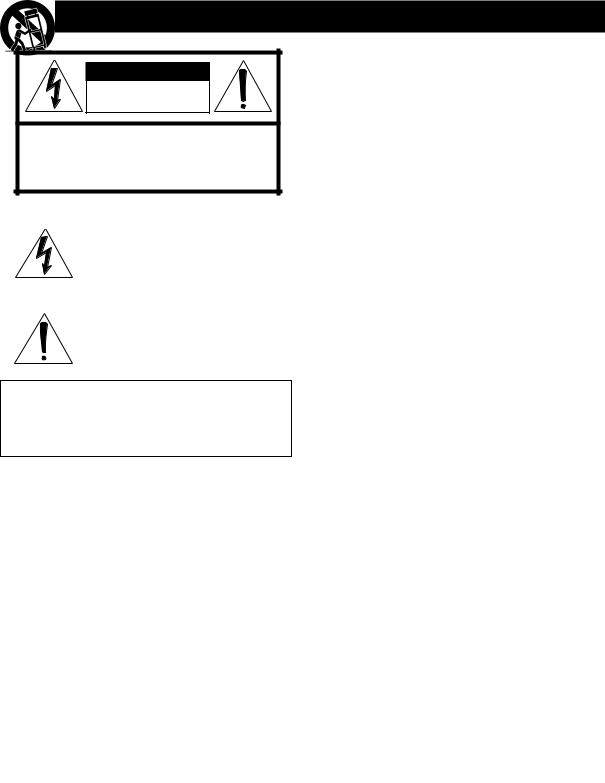
SAFETY INSTRUCTIONS
CAUTION |
RISK OF ELECTRIC SHOCK |
DO NOT OPEN |
CAUTION: TO REDUCE THE RISK OF |
ELECTRIC SHOCK, DO NOT REMOVE |
COVER (OR BACK). NO USER-SERVICEABLE |
PARTS INSIDE. REFER SERVICING TO |
QUALIFIED SERVICE PERSONNEL. |
•Explanation of Graphical Symbols
The lightning flash with arrowhead symbol, within an equilateral triangle, is intended to alert you to the presence of uninsulated “dangerous voltage” within the product’s enclosure that may be of sufficient magnitude to constitute a risk of electric shock to persons.
The exclamation point within an equilateral triangle is intended to alert you to the presence of important operating and maintenance (servicing) instructions in the literature accompanying the appliance.
WARNING
TO REDUCE THE RISK OF FIRE OR
ELECTRIC SHOCK, DO NOT EXPOSE THIS UNIT TO
RAIN OR MOISTURE.
1Read Instructions – All the safety and operating instructions should be read before the unit is operated.
2Retain Instructions – The safety and operating instructions should be retained for future reference.
3Heed Warnings – All warnings on the unit and in the operating instructions should be adhered to.
4Follow Instructions – All operating and other instructions should be followed.
5Water and Moisture – The unit should not be used near water – for example, near a bathtub, washbowl, kitchen sink, laundry tub, in a wet basement, or near a swimming pool, etc.
6Carts and Stands – The unit should be used only with a cart or stand that is recommended by the manufacturer.
6A A unit and cart combination should be moved with care. Quick stops, excessive force, and uneven surfaces may cause the unit and cart combination to overturn.
7Wall or Ceiling Mounting – The unit should be mounted to a wall or ceiling only as recommended by the manufacturer.
8Ventilation – The unit should be situated so that its location or position does not interfere with its proper ventilation. For example, the unit should not be situated on a bed, sofa, rug, or similar surface, that may block the ventilation openings; or placed in a built-in installation, such as a bookcase or cabinet that may impede the flow of air through the ventilation openings.
9Heat – The unit should be situated away from heat sources such as radiators, stoves, or other appliances that produce heat.
10Power Sources – The unit should be connected to a power supply only of the type described in the operating instructions or as marked on the unit.
11Power-Cord Protection – Power-supply cords should be routed so that they are not likely to be walked on or pinched by items placed upon or against them, paying particular attention to cords at plugs, convenience receptacles, and the point where they exit from the unit.
12Cleaning – The unit should be cleaned only as recommended by the manufacturer.
13Nonuse Periods – The power cord of the unit should be unplugged from the outlet when left unused for a long period of time.
14Object and Liquid Entry – Care should be taken so that objects do not fall into and liquids are not spilled into the inside of the unit.
15Damage Requiring Service – The unit should be serviced by qualified service personnel when:
A.The power-supply cord or the plug has been damaged; or
B.Objects have fallen, or liquid has been spilled into the unit; or
C.The unit has been exposed to rain; or
D.The unit does not appear to operate normally or exhibits a marked change in performance; or
E.The unit has been dropped, or the cabinet damaged.
16Servicing – The user should not attempt to service the unit beyond those means described in the operating instructions. All other servicing should be referred to qualified service personnel.
17Power Lines – An outdoor antenna should be located away from power lines.
18Grounding or Polarization – Precautions should be taken so that the grounding or polarization is not defeated.
CAUTION

19For US customers only:
Outdoor Antenna Grounding – If an outside antenna is connected to this unit, be sure the antenna system is grounded so as to provide some protection against voltage surges and built-up static charges. Article 810 of the National Electrical Code, ANSI/NFPA 70, provides information with regard to proper grounding of the mast and supporting structure, grounding of the lead-in wire to an antenna discharge unit, size of grounding conductors, location of antenna discharge unit, connection to grounding electrodes, and requirements for the grounding electrode.
Note to CATV system installer:
This reminder is provided to call the CATV system installer’s attention to Article 820-40 of the NEC that provides guidelines for proper grounding and, in particular, specifies that the cable ground shall be connected to the grounding system of the building, as close to the point of cable entry as practical.
SAFETY INSTRUCTIONS
EXAMPLE OF ANTENNA GROUNDING
MAST |
ANTENNA |
INTRODUCTION |
SERVICE |
LEAD IN |
|
|
WIRE |
|
GROUND |
|
|
CLAMP |
|
|
|
ANTENNA |
|
|
DISCHARGE UNIT |
|
|
(NEC SECTION 810–20) |
|
ELECTRIC |
|
|
EQUIPMENT |
GROUNDING CONDUCTORS |
|
|
|
|
|
(NEC SECTION 810–21) |
|
|
GROUND CLAMPS |
|
|
POWER SERVICE GROUNDING |
|
|
ELECTRODE SYSTEM |
|
|
(NEC ART 250. PART H) |
|
NEC – NATIONAL ELECTRICAL CODE |
|
|
FCC INFORMATION (for US customers only)
1.IMPORTANT NOTICE : DO NOT MODIFY THIS UNIT!
This product, when installed as indicated in the instructions contained in this manual, meets FCC requirements. Modifications not expressly approved by
Yamaha may void your authority, granted by the FCC, to use the product.
2.IMPORTANT : When connecting this product to accessories and/or another product use only high quality shielded cables. Cable/s supplied with this product MUST be used. Follow all installation instructions. Failure to follow instructions could void your FCC authorization to use this product in the USA.
3.NOTE : This product has been tested and found to comply with the requirements listed in FCC Regulations, Part 15 for Class “B” digital devices. Compliance with these requirements provides a reasonable level of assurance that your use of this product in a residential environment will not result in harmful interference with other electronic devices.
This equipment generates/uses radio frequencies and, if not installed and used according to the instructions found in the users manual, may cause interference harmful to the operation of other electronic devices.
Compliance with FCC regulations does not guarantee that interference will not occur in all installations. If this product is found to be the source of interference, which can be determined by turning the unit “OFF” and “ON”, please try to eliminate the problem by using one of the following measures:
Relocate either this product or the device that is being affected by the interference.
Utilize power outlets that are on different branch (circuit breaker or fuse) circuits or install AC line filter/ s.
In the case of radio or TV interference, relocate/ reorient the antenna. If the antenna lead-in is 300 ohm ribbon lead, change the lead-in to coaxial type cable.
If these corrective measures do not produce satisfactory results, please contact the local retailer authorized to distribute this type of product. If you can not locate the appropriate retailer, please contact Yamaha Electronics Corp., U.S.A. 6660 Orangethorpe Ave,
Buena Park, CA 90620.
The above statements apply ONLY to those products distributed by Yamaha Corporation of America or its subsidiaries.
We Want You Listening For A Lifetime
YAMAHA and the Electronic Industries Association’s |
Since hearing damage from loud sounds is often |
Consumer Electronics Group want you to get the most out of |
undetectable until it is too late, YAMAHA and the |
your equipment by playing it at a safe level. One that lets the |
Electronic Industries Association’s Consumer |
sound come through loud and clear without annoying blaring |
Electronics Group recommend you to avoid |
or distortion – and, most importantly, without affecting your |
prolonged exposure from excessive volume |
sensitive hearing. |
levels. |
English
CAUTION

CAUTION: READ THIS BEFORE OPERATING YOUR UNIT.
1.To assure the finest performance, please read this manual carefully. Keep it in a safe place for future reference.
2.Install this unit in a cool, dry, clean place — away from windows, heat sources, sources of excessive vibration, dust, moisture and cold. Avoid sources of humming (transformers, motors). To prevent fire or electrical shock, do not expose the unit to rain or water.
3.Never open the cabinet. If something drops into the unit, contact your dealer.
4.Do not use force on switches, controls or connection wires. When moving the unit, first disconnect the power cord and then the wires connected to other component. Never pull the wires themselves.
5.The openings on the cover assure proper ventilation of the unit. If these openings are obstructed, the temperature inside the unit will rise rapidly. Therefore, avoid placing objects against these openings, and install the unit in a well-ventilated area to prevent fire and damage.
6.The voltage used must be the same as that specified on this unit. Using this unit with a higher voltage than specified is dangerous and may result in fire or other accidents. YAMAHA will not be held responsible for any damage resulting from the use of this unit with a voltage other than that specified.
7.Digital signals generated by this unit may interfere with other component such as tuners, receivers and TVs. Move this unit farther away from such component if interference is observed.
8.Always set VOLUME to the “ m” position before starting the audio source play. Increase the volume gradually to an appropriate level after playback has been started.
9.Do not attempt to clean the unit with chemical solvents; this might damage the finish. Use a clean, dry cloth.
10.Be sure to read the “TROUBLESHOOTING” section regarding common operating errors before concluding that the unit is faulty.
11.When not planning to use this unit for a long period of time (e.g., a vacation), disconnect the AC power cord from the wall outlet.
12.To prevent lightning damage, disconnect the AC power cord and disconnect the antenna cable when there is an electrical storm.
13.Grounding or polarization — Precautions should be taken so that the grounding or polarization of the unit is not defeated.
14.AC outlet — Do not connect audio component to the AC outlet on the rear panel if that component requires more power than the outlet is rated to provide.
This unit is not disconnected from the AC power source as long as it is connected to the wall outlet, even if this unit itself is turned off. This state is called the standby mode. In this state, this unit is designed to consume a very small quantity of power.
IMPORTANT
Please record the serial number of this unit in the space below.
MODEL:
Serial No.:
The serial number is located on the rear of the unit. Retain this Owner’s Manual in a safe place for future reference.
WARNING
TO REDUCE THE RISK OF FIRE OR ELECTRIC SHOCK, DO NOT EXPOSE THIS UNIT TO RAIN OR MOISTURE.
FOR CANADIAN CUSTOMERS
To prevent electric shock, match wide blade of plug to wide slot and fully insert.
This Class B digital apparatus complies with Canadian ICES-003.
CAUTION

FEATURES |
CONTENTS |
5-Channel Power Amplification
Minimum RMS Output
(0.06% THD, 20 Hz – 20 kHz)
Main: |
60 W + 60 W (8 Ω) |
Center: |
60 W (8 Ω) |
Rear: |
60 W + 60 W (8 Ω) |
Multi-mode Digital Sound Field
Processing
Digital Sound Field Processor (DSP)
Dolby Digital Decoder
Dolby Pro Logic Decoder
CINEMA DSP: Theater-like Sound Experience by the Combination of YAMAHA DSP Technology and Dolby Digital or Dolby Pro Logic
Automatic Input Balance Control for Dolby Pro Logic decoding
Sophisticated FM/AM Tuner
40-Station Random Access Preset Tuning
Automatic Preset Tuning
Preset Station Shifting Capability (Preset Editing)
Other Features
“SET MENU” which Provides You with 10 Items for Optimizing This Unit for Your Audio/Video System
Test Tone Generator for Easier Speaker Balance Adjustment
6-Channel External Decoder Input for Other Future Formats
2 Optical/1 Coaxial Digital Signal Input Terminals
SLEEP Timer
Remote Control with Preset Manufacturer Codes
Manufactured under license from Dolby Laboratories. “Dolby”, “Pro Logic” and the double-D symbol are trademarks of Dolby Laboratories. Confidential Unpublished Works. ©1992 – 1997 Dolby Laboratories, Inc. All rights reserved.
INTRODUCTION |
|
INTRODUCTION |
|
|
|
||
FEATURES .................................................................. |
1 |
|
|
CONTENTS ................................................................. |
1 |
|
|
GETTING STARTED ................................................. |
2 |
|
|
CONTROLS AND FUNCTIONS ............................... |
4 |
|
|
|
|
|
|
|
|
|
|
PREPARATION |
|
PREPARATION |
|
|
|
||
SPEAKER SETUP ....................................................... |
8 |
|
|
CONNECTIONS .......................................................... |
9 |
|
|
ADJUSTING THE SPEAKER BALANCE ............ |
17 |
|
|
|
|
|
|
|
|
|
|
BASIC OPERATION |
|
BASIC |
|
PLAYING A SOURCE |
19 |
||
|
|||
DIGITAL SOUND FIELD PROCESSOR (DSP) |
|
|
|
EFFECT .................................................................. |
22 |
OPERATION |
|
SOUND FIELD PROGRAM |
23 |
||
|
|||
TUNING ..................................................................... |
26 |
|
|
RECORDING A SOURCE ON TAPE, MD OR |
|
|
|
VIDEO CASSETTE ............................................... |
30 |
|
|
|
|
|
|
|
|
|
|
DELAY TIME AND SPEAKER |
|
ADVANCED |
|
ADVANCED OPERATION |
|
|
|
SET MENU ................................................................. |
31 |
TIONOPERA |
|
OUTPUT LEVELS |
35 |
||
|
|||
SLEEP TIMER .......................................................... |
37 |
|
|
PRESET REMOTE CONTROL .............................. |
38 |
|
|
|
|
|
|
|
|
|
|
APPENDIX |
|
APPENDIX |
|
TROUBLESHOOTING |
45 |
||
|
|||
SPECIFICATIONS .................................................... |
48 |
|
|
GLOSSARY ................................................................ |
49 |
|
|
INDEX ........................................................................ |
50 |
|
|
|
|
|
|
yindicates a tip for your operation. |
|
|
|
|
English |
||
|
|
||
|
|
|
1
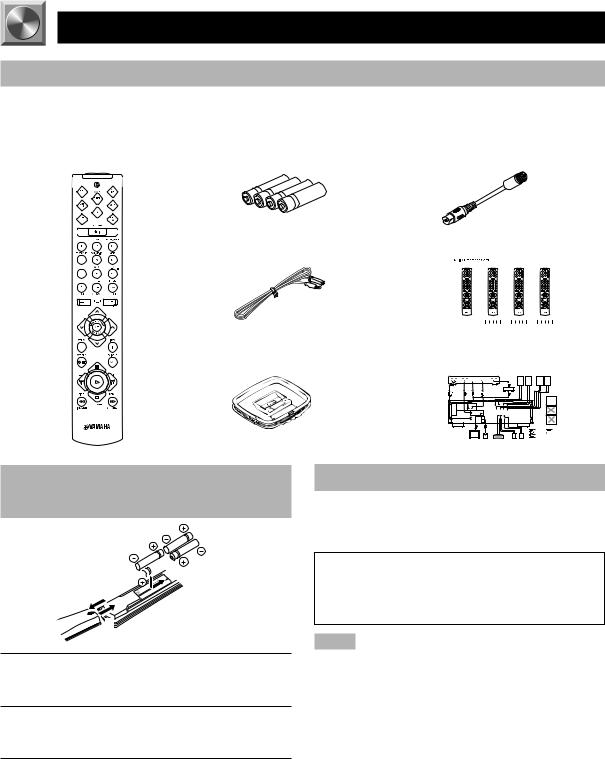
GETTING STARTED
Checking the Package Contents
Check that the following items are included in your package.
Remote control |
Batteries (AAA, R03, UM-4 type) |
Antenna adapter |
|
|
(U.S.A. and Canada models only) |
Indoor FM antenna |
Quick reference card |
|||||||
|
|
|
|
|
|
|
|
|
|
|
|
|
|
|
|
|
|
|
|
|
|
|
|
|
|
|
|
|
|
|
|
|
|
|
|
AM loop antenna |
Connection guide |
|
|
|
|
|
|
|
||||||||||||||||||||||||||||||
|
|
|
|
|
|
|
|
|
|
|
|
|
|
|
|
|
|
|
|
|
|
|
|
|
|
|
|
|
|
|
|
|
|
|
|
|
|
|
|
|
|
|
|
|
|
|
|
|
|
|
|
|
|
|
|
|
|
|
|
|
|
|
|
|
|
|
|
|
|
|
|
|
|
|
|
|
|
|
|
|
|
|
|
|
|
|
|
|
|
|
|
|
|
|
|
|
|
|
|
|
|
|
|
|
|
|
|
|
|
|
|
|
|
|
|
|
|
|
|
|
|
|
|
|
|
|
|
|
|
|
|
|
|
|
|
|
|
|
|
|
|
|
|
|
|
|
|
|
|
|
|
|
|
|
|
|
|
|
|
|
|
|
|
|
|
|
|
|
|
|
|
|
|
|
|
|
|
|
|
|
|
|
|
|
|
|
|
|
|
|
|
|
|
|
|
|
|
|
|
|
|
|
|
|
|
|
|
|
|
|
|
|
|
|
|
|
|
|
|
|
|
|
|
|
|
|
|
|
|
|
|
|
|
|
|
|
|
|
|
|
|
|
|
|
|
|
|
|
|
|
|
|
|
|
|
|
|
|
|
|
|
|
|
|
|
|
|
|
|
|
|
|
Battery Installation in the Remote
Control
2 
1
3
1Turn the remote control over and slide the battery compartment cover in the direction of the arrow.
2Insert the batteries (AAA, R03 or UM-4 type) according the polarity markings on the inside of the battery compartment.
3 Close the battery compartment cover.
Battery Replacement
If the remote control operates only when it is close to the unit, the batteries are weak. Replace all the batteries with new ones.
Be sure to replace the batteries within about two minutes. If it takes longer than two minutes, the codes preset for the remote control will return to the factory settings. (Refer to pages 38 to 44 about the remote control.)
Notes
•Use only AAA, R03 or UM-4 batteries for replacement.
•Be sure the battery polarity is correct. (See the illustration inside the battery compartment.)
•Remove the batteries if the remote control will not be used for an extended period of time.
•If the batteries have leaked, dispose of them immediately. Avoid touching the leaked material or letting it come into contact with clothing, etc. Clean the battery compartment thoroughly before installing new batteries.
2
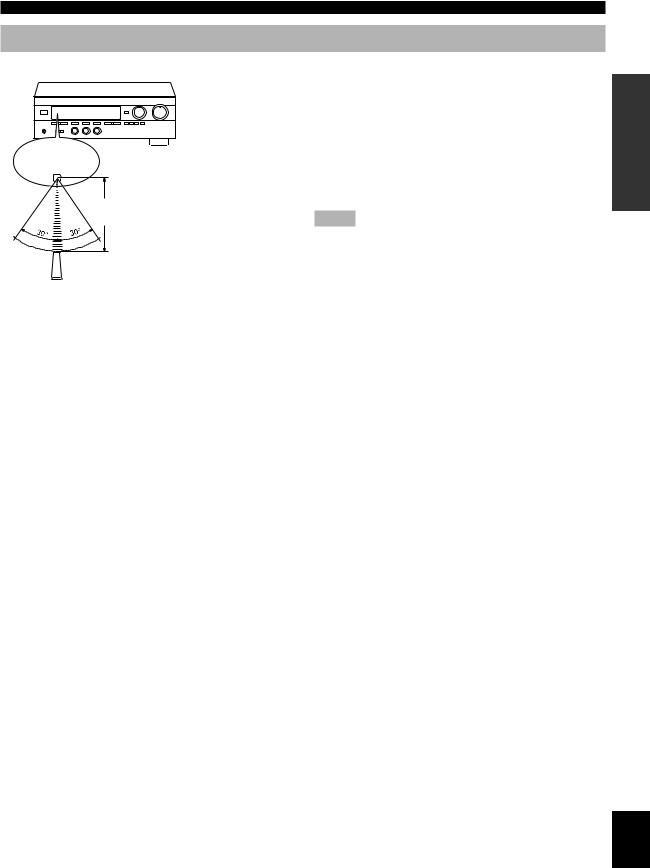
Using the Remote Control
Remote control sensor
Within approximately 6 m (20 feet)
GETTING STARTED
The remote control transmits a directional infrared beam. Be |
|
sure to aim the remote control directly at the infrared sensor |
|
during operation. When the sensor is covered or there is a |
INTRODUCTION |
|
large object between the remote control and the sensor, the sensor cannot receive signals. The sensor may not be able to receive signals properly when it is exposed to direct sunlight or a strong artificial light (such as a fluorescent or strobe light). In this case, change the direction of the light or reposition the unit to avoid direct lighting.
Notes
•Handle the remote control with care.
•Do not spill water, tea or other liquids on the remote control.
•Do not drop the remote control.
•Do not leave or store the remote control in the following conditions:
–high humidity or temperature such as near a heater, stove or bath;
–dusty places; or
–extremely low temperature.
English
3
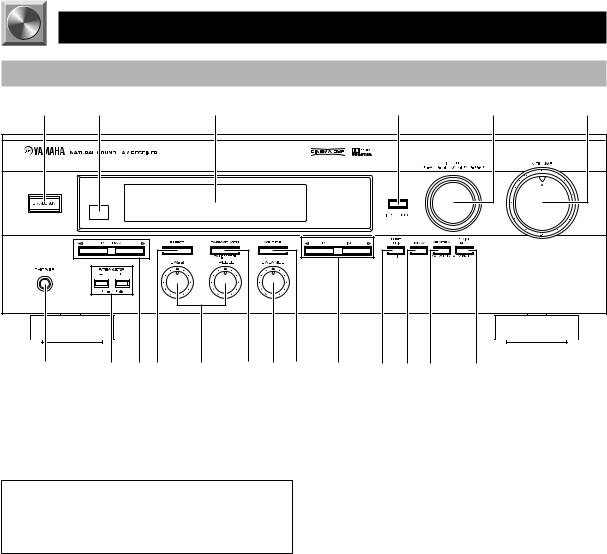
CONTROLS AND FUNCTIONS
Front Panel
1 |
2 |
|
3 |
|
|
4 |
5 |
6 |
|
– |
+ |
– |
+ |
L |
R |
|
|
7 |
8 9 0 q w e r t y u i o |
|
|
|||||
1 STANDBY/ON |
|
|
|
|
6 VOLUME |
|
|
|
Press this switch to turn on the power of this unit or to set this unit in the standby mode. Before turning the power on, set VOLUME to the “ m” position.
Standby mode
In this mode, this unit consumes a very small quantity of power to receive infrared-signals from the remote control.
2 Remote control sensor
This receives signals from the remote control.
3 Display
This shows various information. (Refer to page 6 for details.)
4 INPUT MODE
Press this button to select the input mode between AUTO and ANALOG for the DVD/LD, TV/digital TV and satellite tuner sources.
5 INPUT
Turn this selector to select the input source (VCR, SAT/D- TV, DVD/LD, TUNER, CD, AUX) that you want to listen to or watch. The name of the selected input source appears on the display.
Turn this control to turn up or down the volume.
7 PHONES jack
Connect the headphones to the PHONES jack. You can listen to the sound to be output from the main speakers through the headphones.
When using headphones only, set both SPEAKERS A and B to the OFF position and press EFFECT to turn off the effect speakers (center and rear) (so that no DSP program indicator lights up on the display).
8 SPEAKERS
Set A or B (or both A and B) to the ON position for the main speaker system (connected to this unit) that you want to use. Set the button(s) to the OFF position for the main speaker system that you don’t want to use.
9 PROGRAM selector
Press l or h to select a DSP program when the effect speakers (center and rear) are turned on. The selected program indicator lights up on the display.
0 EFFECT
Press this button to turn on or off the effect speakers (center and rear). If you turn them off, all Dolby Digital audio signals are directed to the right and left main speakers. In that case, the output levels of the right and left speakers may not match.
4

q Tone controls
These controls are only effective for the sound from the main speakers.
a) BASS
Turn this control clockwise to increase or counterclockwise to decrease the low-frequency response. The “0” position produces a flat response.
b) TREBLE
Turn this control clockwise to increase or counterclockwise to decrease the high-frequency response. The “0” position produces a flat response.
w TAPE/MD MON / EXT. DECODER
Press this button to select a tape or an MD source. The “TAPE/MD MONITOR” indicator lights up on the display. When you press the button next, the “TAPE/MD MONITOR” indicator goes off, “EXT. DECODER” appears on the display and you can listen to a source connected to the EXTERNAL DECODER INPUT terminals.
e BALANCE
This control is only effective for the sound from the main speakers.
Turn the control to adjust the balance of the output volume from the right and left main speakers to compensate for sound imbalance caused by the speaker location or listening room conditions.
r A/B/C/D/E
Press this button to select one of a group (A to E) of preset stations.
CONTROLS AND FUNCTIONS
t PRESET/TUNING
When “ z ” appears
This button is used to select a preset station number (1 to 8). Press h to select a higher and l to select a lower preset station number.
When “ z ” goes off
This button is used for tuning. Press h to tune in to higher frequencies, and l to tune in to lower frequencies.
y PRESET/TUNING, EDIT
Press this button to turn on or off “ z ” on the display and switch the function between for storing a broadcasting station (preset tuning) and for tuning. This button is also used to exchange the assignment of two preset stations with each other.
u FM/AM
Press this button to switch the reception band between FM and AM.
i MEMORY (MAN’L/AUTO FM)
Press this button to store the broadcasting stations. Hold down this button for more than three seconds to begin automatic preset tuning.
o TUNING MODE (AUTO/MAN’L MONO)
Press this button to switch the tuning mode between automatic and manual. To use the automatic tuning method, press this button so that the “AUTO” indicator lights up on the display. To use the manual tuning method, press this button so that the “AUTO” indicator goes off.
INTRODUCTION
English
5

CONTROLS AND FUNCTIONS
Display
1 |
2 |
3 |
4 5 |
6 7 8
1 g and o indicators
“ g ” lights up when the built-in Dolby Digital decoder is on and the signals of the selected source are encoded with Dolby Digital. “ o ” lights up when the built-in Dolby Pro Logic decoder is on.
2 DSP program indicators
The name of the selected DSP program lights up.
3 Multi-information display
This display shows various information: for example the name of the selected input source and the various settings during adjustment with the SET MENU. The current station frequency and band (FM or AM) also appear when the tuner is selected as the input source.
4 SLEEP indicator
This lights up while the built-in SLEEP timer is on.
5 TAPE/MD MONITOR indicator
This lights up when the tape deck or MD recorder, etc. is selected as the input source by pressing TAPE/MD MON / EXT. DECODER (or TAPE/MD).
90
6 x indicator
“ x ” lights up when the built-in digital sound field processor is on.
7 MEMORY indicator
This flashes for about five seconds after pressing MEMORY. During this period, the displayed station can be stored in the memory.
8 AUTO indicator
This lights up when the unit is in the automatic tuning mode.
9 STEREO indicator
This lights up when an FM stereo broadcast with sufficient signal strength is being received.
0 Signal-level indicator
This indicates the signal level of the station being received. If multipath interference is detected, the indication decreases.
6

CONTROLS AND FUNCTIONS
Remote Control
This section describes basic operation of this unit with the remote control. First, press AMP(TUNER) on the component selector. Refer to “PRESET REMOTE CONTROL” on page 38 for full details.
1
Press AMP(TUNER).
2
3
3 POWER
Each time you press this button, the unit switches between the power on and standby mode.
4 TEST
Press this button to output the test tone for each speaker.
5 A/B/C/D/E, PRESET +/–
These buttons are used to select a preset station. A/B/C/D/E: To select one of a group (A to E) of preset
stations
PRESET +/–: To select a preset station number (1 to 8)
6 MUTE
q
4 



 w
w
5
6
TV VOLUME
7
8
 TV INPUT
TV INPUT
9
e
0 r
1 Indicator
This flashes in red when pressing a button on the remote control. If it flashes rapidly several times, press the selected button again.
2 Component selector buttons
Press one of these buttons which corresponds to the component you want to control with the remote control. (The proper code must be set for your component. Refer to “Setup codes” on page 43.) When the component selector button has been pressed, the remote control is set to that component operation mode.
Press this button to mute the sound. To cancel mute, press this button again.
7 VOLUME
These buttons are used to adjust the volume level. u: To turn up the volume
d: To turn down the volume
8 SLEEP
Press this button to set the SLEEP timer.
9 +/–
These buttons adjust the settings of the SET MENU and TIME/LEVEL mode.
0 TIME/LEVEL
Press this button to select the items in the TIME/LEVEL mode.
q Input selector buttons
These buttons select the input source.
CD: |
To play a CD |
TUNER: |
To listen to an FM or AM broadcast |
TAPE/MD: |
To play a tape or MD |
DVD/LD: |
To play a DVD or LD |
SAT/D-TV: |
To watch a TV or satellite broadcast |
VCR: |
To play a video cassette |
AUX: |
To use another audio component |
EXT. DEC.: |
To play other multi-channel source |
w EFFECT
Press this button to turn on or off the effect speakers (center and rear).
e PRG+, PRG–
Press these buttons to select a DSP program.
r SET MENU
Press this button to select the items in the SET MENU.
INTRODUCTION
English
7
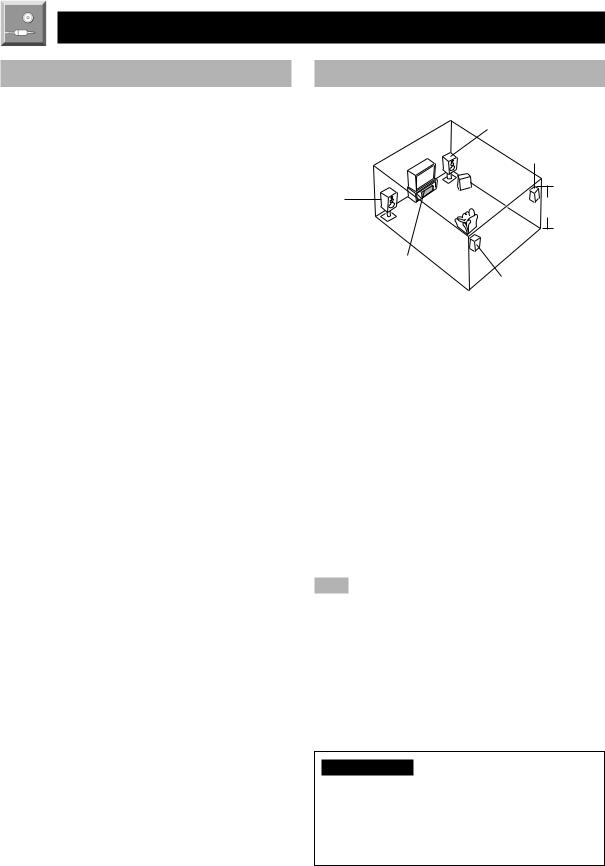
PREPARATION
SPEAKER SETUP
Speakers to Be Used
This unit is designed to provide the best sound-field quality with a 5-speaker system, using main speakers, rear speakers and a center speaker. If you use different brands of speakers (with different tonal qualities) in your system, the tone of a moving human voice and other types of sound may not shift smoothly. We recommend that you use speakers from the same manufacture or speakers with the same tonal quality.
The main speakers are used for the main source sound plus the effect sounds. They will probably be the speakers from your present stereo system. The rear speakers are used for the effect and surround sounds, and the center speaker is for the center sounds (dialog, vocals, etc.). If for some reason it is not practical to use a center speaker, you can do without it. Best results, however, are obtained with the full system.
The main speakers should be high-performance models and have enough power-handling capacity to accept the maximum output of your audio system. The other speakers do not have to be equal to the main speakers. For precise sound localization, however, it is ideal to use highperformance models that can reproduce sounds over the full range for the center speaker and the rear speakers.
■Use of a subwoofer expands your sound field
It is also possible to further expand your system with the addition of a subwoofer. The use of a subwoofer is effective not only for reinforcing bass frequencies from any or all channels, but also for reproducing the LFE (low frequency effect) channel with high fidelity when playing back a source encoded with Dolby Digital. The YAMAHA Active Servo Processing Subwoofer System is ideal for natural and lively bass reproduction.
Speaker Placement
Refer to the following diagram when you place the |
|
speakers. |
Main speaker (R) |
|
|
|
Rear speaker (R) |
|
Subwoofer |
Main |
1.8 m |
speaker (L) |
|
Center speaker
Rear speaker (L)
■ Main speakers
Place the right and left main speakers an equal distance from the ideal listening position. The distance of each speaker from each side of the TV monitor should be the same.
■ Rear speakers
Place these speakers behind your listening position, facing slightly inwards, nearly 1.8 m (approx. 6 feet) above the floor.
■ Center speaker
Align the front face of the center speaker with the front face of your TV monitor. Place the speaker as close to the monitor as possible, such as directly over or under the monitor and centrally between the main speakers.
Note
• If the center speaker is not used, the sound will be heard from the right and left main speakers. In that case, “CENTER SP” in the SET MENU is set to the NONE position. (Refer to page 32 for details.)
■ Subwoofer
The position of the subwoofer is not so critical, because low bass sounds are not highly directional. But it is better to place the subwoofer near the main speakers. Turn it slightly toward the center of the room to reduce the wall reflections.
CAUTION
Some types of speakers interfere with a TV monitor. If this problem occurs, move the speakers away from the monitor. If you cannot avoid installing the center speaker or subwoofer near the TV monitor, use magnetically shielded speakers.
8

CONNECTIONS
Before Connecting Components
CAUTION
Never connect this unit and other components to mains power until all connections between components have been completed.
Be sure all connections are made correctly, that is to say L (left) to L, R (right) to R, “+” to “+” and “–” to “–”. Some components require different connection methods and have different terminal names. Refer to the instructions for each component to be connected to this unit.
When you connect other YAMAHA audio components (such as a tape deck, MD recorder and CD player or changer), connect it to the terminals with the same number labels as !, #, $ etc. YAMAHA applies this labeling system to all its products.
Use RCA-type pin plug cables for connecting audio/video components with the exception described later.
The input and output terminals for pin plugs can be distinguished as follows:
Yellow |
video signals (composite) |
V |
V |
White |
analog audio signals for the left channel |
L |
L |
Red |
analog audio signals for the right channel |
R |
R |
|
coaxial digital signals |
C |
C |
After completing all connections, check them again to make sure they are correct.
PREPARATION
Connecting the |
Connecting to an External |
Connecting Speakers |
Connecting the Power |
Antenna (page 10) |
Decoder (page 12) |
(page 14) |
Supply Cords (page 16) |
(U.S.A. model)
+ |
R |
– |
MAIN |
– |
L |
|
+ |
|
|
|
|
|
|
|
|
|
|
|
|
|
MAINS |
|
|
|
|
|
|
|
|
A |
|
|
|
|
|
|
|
|
|
|
B |
|
|
|
|
|
|
|
|
|
|
SET BEFORE POWER ON |
120 V 60Hz |
|
|
|
|
|
|
|
|
|
MAIN A OR B : 4ΩMIN. /SPEAKER |
100W MAX. TOTAL |
|
|
|
|
R |
|
REAR |
L |
|
SWITCHED |
||
|
CENTER |
(SURROUND) |
|
|
||||||
|
|
|
|
|
|
|
|
A + B : 8ΩMIN. /SPEAKER |
|
|
|
|
|
|
|
|
|
|
CENTER |
: 6ΩMIN. /SPEAKER |
|
|
+ |
|
|
|
|
|
+ |
REAR |
: 6ΩMIN. /SPEAKER |
|
|
|
|
|
|
|
MAIN A OR B : 8ΩMIN. /SPEAKER |
|
|||
|
|
|
|
|
|
|
|
A + B :I6ΩMIN. /SPEAKER |
|
|
|
|
|
|
|
|
|
|
CENTER |
: 8ΩMIN. /SPEAKER |
|
|
– |
|
|
|
|
|
– |
REAR |
: 8ΩMIN. /SPEAKER |
|
|
|
|
|
|
|
|
|
|
|
|
|
|
|
|
|
|
|
|
Connecting an Audio |
Connecting a Video |
IMPEDANCE SELECTOR |
|||||
|
Component (page 12) |
Component (page 13) |
switch (page 16) |
|||||
English
9
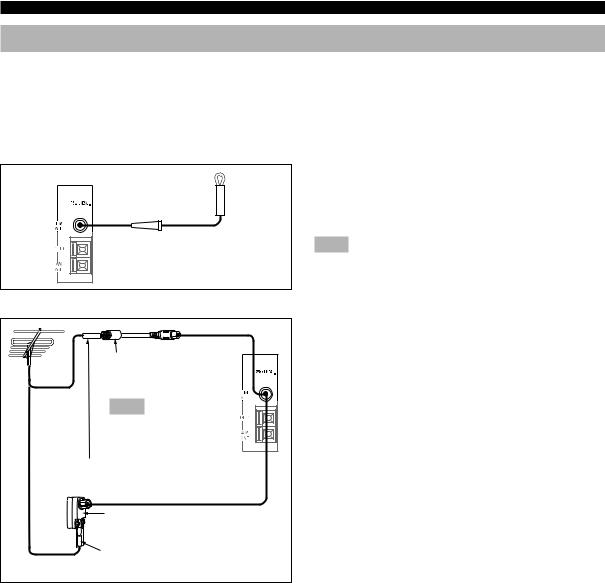
CONNECTIONS
Connecting the Antennas
Both AM and FM indoor antennas are included with this unit. In general, these antennas should provide sufficient signal strength. However, a properly installed outdoor antenna provides clearer reception than an indoor one. If you experience poor reception quality, an outdoor antenna may improve the quality.
Connect each antenna correctly to the designated terminals.
■ Indoor FM antenna (included)
Indoor FM antenna
Firmly insert the connector into the FM ANT terminal. The indoor FM antenna is only a simple antenna. For reception with better sound quality, installing the outdoor FM antenna (commercially available) is recommended.
Note
• Do not connect an outdoor FM antenna and the indoor FM antenna at the same time.
■ Outdoor FM antenna |
Antenna adapter |
(included for U.S.A. and |
Canada models) |
Note |
Use this adapter to match |
with F-type connector |
75-ohm coaxial cable |
75-ohm/300-ohm antenna |
adapter |
300-ohm feeder |
You may be unable to obtain good FM radio reception depending on your local conditions (distance from the broadcasting station, interposing buildings and mountains, etc.). Consult your dealer or authorized service
center and be sure to install an antenna that suits your local conditions.
Install the outdoor FM antenna (commercially available) in a high place as far away from any roads as possible to avoid being affected by automobile ignition noise.
10
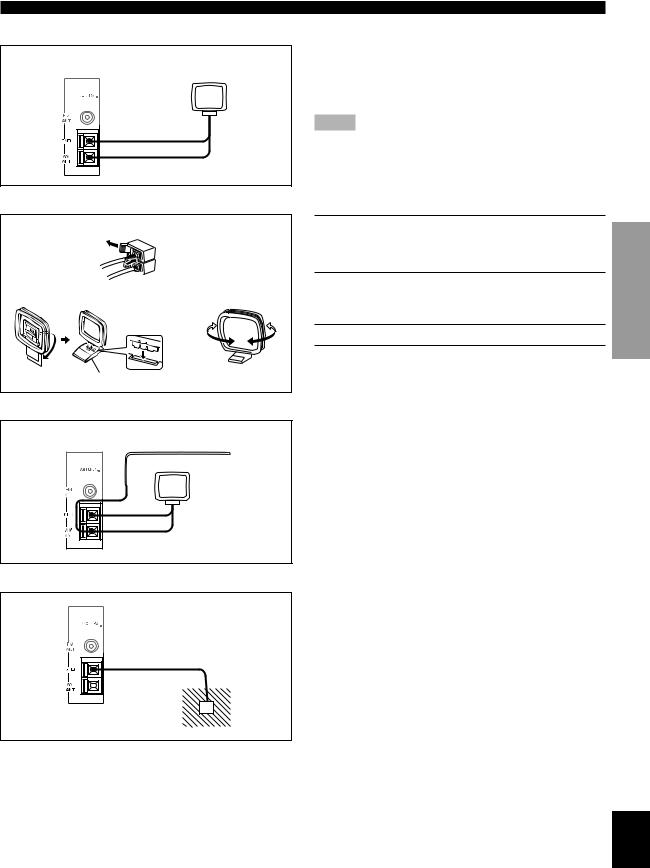
■ AM loop antenna (included)
AM loop antenna
■ Connecting the AM loop antenna
1
3
2
4 |
5 |
Antenna stand
■ Outdoor AM antenna
Vinyl covered wire (5 m to 10 m)
■ Ground (GND terminal)
CONNECTIONS
The AM loop antenna can be removed from the stand and attached to a wall, etc. However, note that the reception sensitivity may deteriorate if the antenna is attached to a metal or steel reinforced wall.
Notes
•The AM loop antenna should be placed away from this unit.
•The AM loop antenna should always be connected, even if an outdoor AM antenna is connected to this unit.
1 Press the tab and unlock the terminal hole. |
|
|
2 Insert the AM loop antenna lead wires into the |
PREPARATION |
|
AM ANT and GND terminals. |
||
|
3 Return the tab to its original position to lock the lead wires. Lightly pull the lead wires to confirm a good connection.
4 Attach the loop antenna to the antenna stand.
5Orient the AM loop antenna so that the best reception is obtained.
If you cannot obtain good reception with the AM loop antenna, connect 5 m to 10 m of vinyl covered wire to the AM ANT terminal and extend it outdoors from a window.
For maximum safety and minimum interference, connect the antenna GND terminal to a good earth ground. A good earth ground is a metal stake driven into moist earth.
English
11
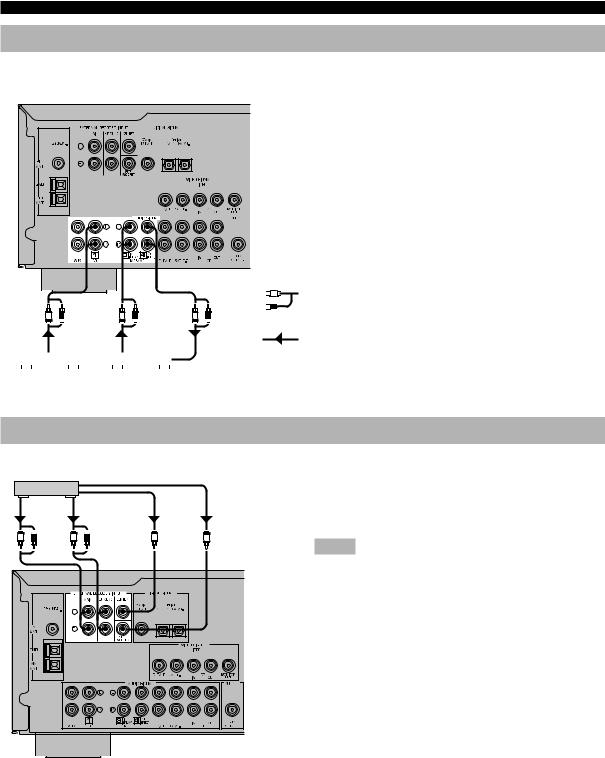
CONNECTIONS
Connecting an Audio Component
|
|
|
|
|
|
|
|
|
|
|
|
|
|
|
|
|
|
Be sure to connect the right channel (R), left channel (L), |
|
|
|
|
|
|
|
|
|
|
|
(U.S.A. model) |
input (IN) and output (OUT) properly. |
||||||
|
|
|
|
|
|
|
|
|
|
|
|
|
|
|
|
|
|
|
|
|
|
|
|
|
|
|
|
|
|
|
|
|
|
|
|
|
|
|
|
|
|
|
|
|
|
|
|
|
|
|
|
|
|
|
|
|
|
|
|
|
|
|
|
|
|
|
|
|
|
|
|
|
|
|
|
|
|
|
|
|
|
|
|
|
|
|
|
|
|
|
|
|
|
|
|
|
|
|
|
|
|
|
|
|
|
|
|
|
|
|
|
|
|
|
|
|
|
|
|
|
|
|
|
|
|
|
|
|
|
|
|
|
|
|
|
|
|
|
|
|
|
|
|
|
|
|
|
|
|
|
|
|
|
|
|
|
|
|
|
|
|
|
|
|
|
|
|
|
|
|
|
|
|
|
|
|
|
|
|
|
|
|
|
|
|
|
|
|
|
|
|
|
|
|
|
|
|
|
|
|
|
|
|
|
|
|
|
|
|
|
|
|
|
|
|
|
|
|
|
|
|
|
|
|
|
|
|
|
|
|
|
|
|
|
|
|
|
|
|
|
|
|
|
|
|
|
L |
R |
OUTPUT
L |
R |
LINE OUT
L |
R |
LINE IN



 L
L 





 R
R 


Analog signal
Signal flow
|
|
|
|
|
|
|
|
|
|
|
|
|
|
|
|
|
CD player |
|
Tape deck or |
||||
|
|
|
|
|
MD recorder |
||
Connecting to an External Decoder
External decoder
MAIN |
SURROUND |
CENTER |
SUBWOOFER |
OUT |
OUT |
OUT |
OUT |
L R |
L R |
|
(U.S.A. |
|
|
|
|
|
|
|
model) |
This unit has additional 6-channel audio signal input terminals for connecting an external decoder to this unit. Connect the 6-channel audio signal output terminals of the decoder to the EXTERNAL DECODER INPUT terminals of this unit.
Notes
•When a source connected to these terminals is selected, the digital sound field processor cannot be used.
•The settings of “CENTER SP”, “REAR SP”, “MAIN SP” and “BASS OUT” in the SET MENU have no effect on a source connected to these terminals. The setting of “MAIN LVL” is effective. (Refer to pages 32 and 33 for details.)
12
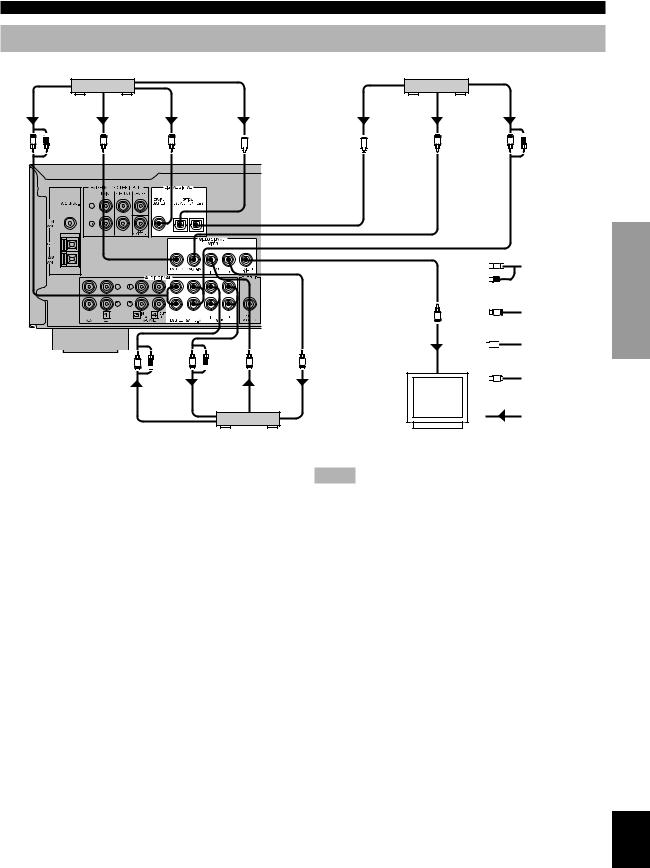
CONNECTIONS
Connecting a Video Component
DVD/LD player |
|
|
TV/digital TV, satellite tuner, cable TV |
|||
ANALOG |
VIDEO |
COAXIAL |
OPTICAL |
OPTICAL |
VIDEO |
ANALOG |
AUDIO OUT |
OUT |
DIGITAL OUT |
DIGITAL OUT |
DIGITAL OUT |
OUT |
AUDIO OUT |
L |
R |
V |
C |
O |
O |
(U.S.A. model)
V |
L |
R |
L |
R |
AUDIO OUT
L |
R |
V |
V |
AUDIO |
VIDEO |
VIDEO |
IN |
OUT |
IN |
VCR



 L
L 





 R
R 


 V
V
V

 O
O 
VIDEO
IN



 C
C 


TV monitor
Analog signal
Video signal
Digital signal (optical)
Digital signal (coaxial)
Signal flow
PREPARATION
■ Audio signal terminals
Be sure to connect the right channel (R), left channel (L), input (IN) and output (OUT) properly.
■ Video signal terminals
Be sure to connect the input (IN) and output (OUT) properly.
Notes
•Be sure to attach the covers when the OPTICAL terminals are not being used in order to protect them from dust.
•If your LD player has a Dolby Digital RF signal output terminal, be sure to use the RF demodulator (separately purchased).
•No sound will be heard when connecting your LD player’s Dolby Digital RF signal output terminal directly to this unit’s COAXIAL DVD/LD digital signal input terminal.
■ Digital audio signal terminals
If your DVD/LD player, TV/digital TV or satellite tuner, etc. has coaxial or optical digital signal output
terminals, they can be connected to this unit’s COAXIAL and/or OPTICAL digital signal input terminals. To make a connection between the optical digital signal terminals, remove the cover from each terminal, and then connect them by using a commercially available optical fiber cable that conforms to EIA standards. Other cables might not function correctly.
When making connections between the digital signal terminals, you should connect the components to the samenamed analog audio signal terminals of this unit, because a digital signal cannot be recorded by a tape deck, MD recorder or VCR connected to this unit.
y
•The input signal from the DVD/LD input terminals is selected in
the following order of priority with the input mode set to AUTO: COAXIAL terminal → OPTICAL terminal → Analog terminal.
Refer to page 21 for details.
•All digital signal input terminals are applicable to sampling frequencies of 32 kHz, 44.1 kHz and 48 kHz.
English
13
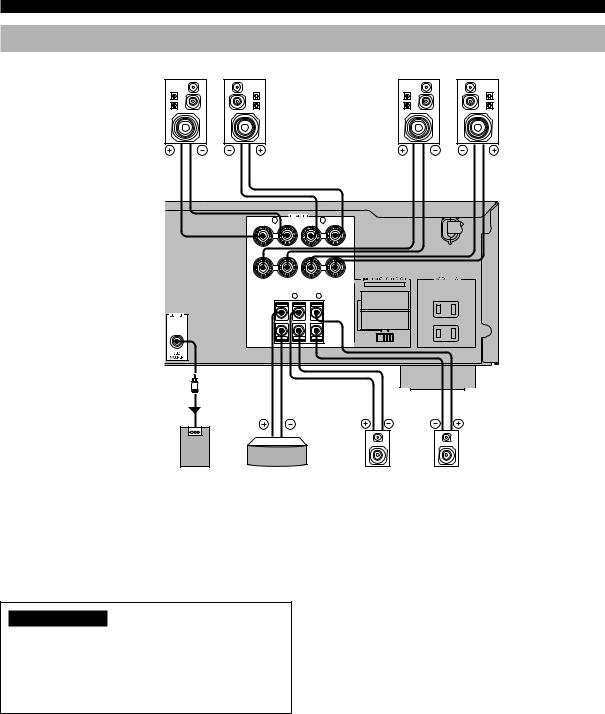
CONNECTIONS
Connecting Speakers
|
Main speakers A |
|
Main speakers B |
Right |
Left |
Right |
Left |
(U.S.A. model)
+ R – MAIN – L +
MAINS
A
B
Subwoofer connection
If you have a subwoofer with builtin amplifier, including the YAMAHA Active Servo Processing Subwoofer System, connect the input terminal of the subwoofer system to the SUBWOOFER OUTPUT terminal of this unit.
|
|
|
SET BEFORE POWER ON |
|
REAR |
L |
|
MAIN A OR B : 4ΩMIN. /SPEAKER |
|
CENTER R (SURROUND) |
|
|||
|
|
|
A + B : 8ΩMIN. /SPEAKER |
|
|
|
|
CENTER |
: 6ΩMIN. /SPEAKER |
+ |
|
+ |
REAR |
: 6ΩMIN. /SPEAKER |
|
MAIN A OR B : 8ΩMIN. /SPEAKER |
|||
|
|
|
A + B :I6ΩMIN. /SPEAKER |
|
|
|
|
CENTER |
: 8ΩMIN. /SPEAKER |
– |
|
– |
REAR |
: 8ΩMIN. /SPEAKER |
120 V 60Hz |
100W MAX. TOTAL |
SWITCHED |
Right |
Left |
Center speaker |
Rear speakers |
Be sure to connect the right channel (R), left channel (L), “+” (red) and “–” (black) properly. If the connections are faulty, no sound will be heard from the speakers, and if the polarity of the speaker connections is incorrect, the sound will be unnatural and lack bass.
CAUTIONS
•Use speakers with the specified impedance shown on the rear panel of this unit.
•Do not let the bare speaker wires touch each other and do not let them touch any metal part of this unit. This could damage the unit and/or speakers.
■ Main speaker terminals
One or two speaker systems can be connected to these terminals. If you use only one speaker system, connect it to either of the SPEAKERS A or B terminals.
■ Rear speaker terminals
A rear speaker system can be connected to these terminals.
■ Center speaker terminal
A center speaker can be connected to this terminal.
14
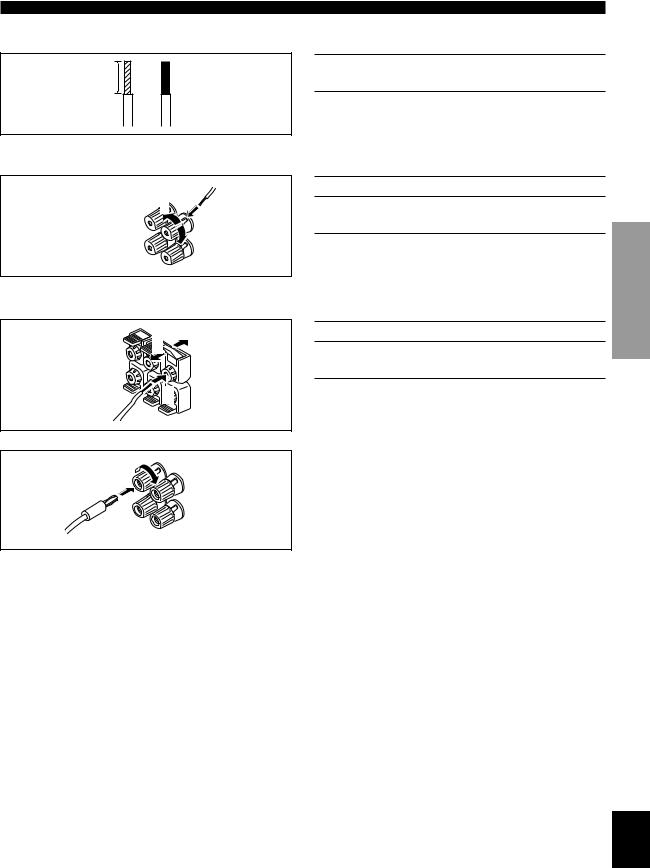
■ Speaker cables
10 mm (3/8”)
CONNECTIONS
1Remove approx. 10 mm (3/8”) of insulation from each of the speaker cable.
2Twist the exposed wires of the cable together to prevent short circuits.
■ Connecting to the MAIN SPEAKERS terminals
Red: positive (+) |
|
2 |
1 Unscrew the knob. |
|
Black: negative (–) |
1 |
2 Insert one bare wire into the hole in the side of |
||
|
||||
|
|
|||
|
|
3 |
each terminal. |
|
|
|
3 Tighten the knob to secure the wire. |
||
■ Connecting to the REAR and CENTER SPEAKERS terminals |
||||
Red: positive (+) |
3 |
1 |
1 Open the tab. |
|
Black: negative (–) |
2 Insert one bare wire into the hole of each |
|||
|
|
|
||
|
|
|
terminal. |
|
|
2 |
|
3 Return the tab to secure the wire. |
|
|
|
|
||
|
|
|
y |
|
|
|
|
Banana plug connections are also possible. Simply insert the |
|
|
|
|
banana plug connector into the corresponding terminal. |
|
PREPARATION
English
15
